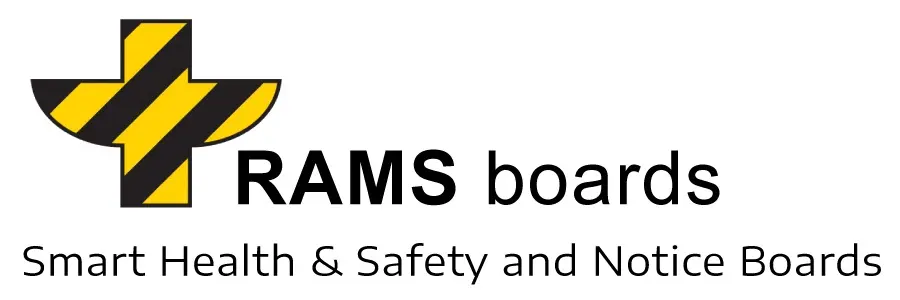Each business is required by law to display certain documents in their premises. Having them posted at a clearly visible focal point is not only best practice—it also demonstrates that you, as an employer, prioritize Health and Safety. This reflects well on your image for both employees and clients, and can boost how you score on tenders that value H&S as part of the bid. Moreover, maintaining compliance may unlock potential financial benefits in new contracts.
Below is the list of documents with short description, which you should have on your notice / information board.
1. HEALTH AND SAFETY LAW POSTER
If you are an employer, you must display the Health and Safety Executive’s (HSE) official Health and Safety Law Poster. An alternative is to provide each person in your organization with an approved leaflet or an equivalent pocket card. However, displaying the poster on a noticeboard where your workers can easily read it is more effective and often cheaper.
Reference: Official HSE “Health and Safety Law” poster or leaflets, which summarize duties under the Health and Safety at Work etc. Act 1974 (HSWA 1974).
- Where to get it: You can purchase the genuine poster (with an HSE hologram) directly from the HSE website. Photocopies or shrunken versions are not compliant.
- Link: HSE website: Health and Safety Law Poster
2. HEALTH AND SAFETY POLICY
If your organization has 5 or more employees, you are required to have a written Health and Safety Policy. While it can be long, many businesses display only the first part (Statement of Intent) on their noticeboard. The Statement of Intent should be signed and dated by the person responsible for health and safety in the workplace. Displaying at least this Statement of Intent is best practice so that everyone is aware of your commitment.
Reference: Under Section 2(3) of HSWA 1974, a written policy is legally required when there are five or more employees.
- Where to find guidance: HSE: How to write a health and safety policy
3. EMPLOYERS LIABILITY INSURANCE
You should display one or more valid copies of your Employer’s Liability Insurance certificate at your premises. This assures employees and clients that your business maintains up-to-date insurance and takes health and safety seriously.
4. FIRST AIDERS AND FIRST AID POINTS
Employers must make appropriate first-aid arrangements for their workplace. This includes listing the names of trained first aiders (or appointed persons) and clearly indicating where the first-aid kit or point is located. The required level of first aid will depend on the size and nature of your business (small office vs. high-risk construction site).
Reference: Health and Safety (First-Aid) Regulations 1981 require employers to provide information on first-aid arrangements.
5. FIRE EVACUATION PLANS AND FIRE WARDEN DETAILS
It is critical that you display clear fire precautions and evacuation routes. This should include general instructions on what to do in the event of a fire, the nearest escape routes, the names of appointed fire wardens or marshals, and where assembly points are located.
Reference: Under the Regulatory Reform (Fire Safety) Order 2005, you must provide employees with information on fire safety arrangements (e.g., Fire Action Notices).
6. ACCIDENT REPORTING PROCEDURE AND RIDDOR
While not mandatory to post the entire process on the board, it is best practice to inform employees of your internal accident-reporting steps. This includes who to contact if an incident occurs and where the Accident Book is kept.
- If a serious incident occurs, you may need to report it to the HSE under RIDDOR 2013 (Reporting of Injuries, Diseases and Dangerous Occurrences Regulations) .
- Recommendation: Display a short “Accident Reporting Procedure” notice detailing the required steps.
7. CDM 2015 (Construction Design and Management Regulations 2015)
For construction projects, CDM 2015 outlines specific legal requirements to ensure health and safety.
- If your project is “notifiable” (e.g., lasting over 30 working days with 20+ workers on site simultaneously or exceeding 500 person-days), you or the client must submit an F10 Notification to the HSE and display a copy on-site .
- Even if not notifiable, the Construction Phase Plan and site rules should be communicated to all workers.
8. SITE RULES AND KEY CONTACTS
Consider displaying a concise “Site Rules” notice. This might cover:
- PPE Requirements (e.g., “Hard Hats Must Be Worn,” “Safety Footwear Must Be Worn,” etc.).
- Speed Limits or restricted areas, if applicable.
- No Alcohol/Drugs Policy or zero tolerance rules.
- The Site Manager’s name and contact information, as well as the First Aider (if different).
- Procedure for reporting hazards and near-misses.
9. ASBESTOS WARNING (IF APPLICABLE)
If you are working on a building that might contain asbestos, you must follow the Control of Asbestos Regulations 2012.
- Clearly mark affected areas with signs such as “Asbestos – Do Not Disturb” to protect workers and remind them not to disturb materials that may contain asbestos .
10. MANDATORY CONSTRUCTION SIGNAGE
To comply with construction-specific safety standards, post signage that covers:
- Entrance Warnings: “Construction Site – Keep Out” / “No Unauthorised Entry.”
- Mandatory PPE Signs (blue circle icons for helmets, hi-vis, boots).
- Hazard Warnings (yellow triangle signs) for deep excavations, overhead loads, demolition, moving vehicles, etc.
- Fire Points (red signs) and Assembly Points (green “running man” or “assembly point” sign).
FINAL NOTES ON BEST PRACTICE
- Stay Current
Always use the latest version of official posters and ensure your policy statements are signed and dated. - Provide Clear Visuals
Diagrams, assembly-point maps, and consistent color-coded safety signs improve effectiveness. - Demonstrate Commitment
Make sure employees and visitors see that you are proactive about health and safety. This not only fulfills legal obligations but also fosters trust.
By incorporating these elements—particularly the construction‑specific sections—your noticeboard and documentation will align more closely with UK regulations and industry best practices, strengthening both compliance and your business’s reputation.

